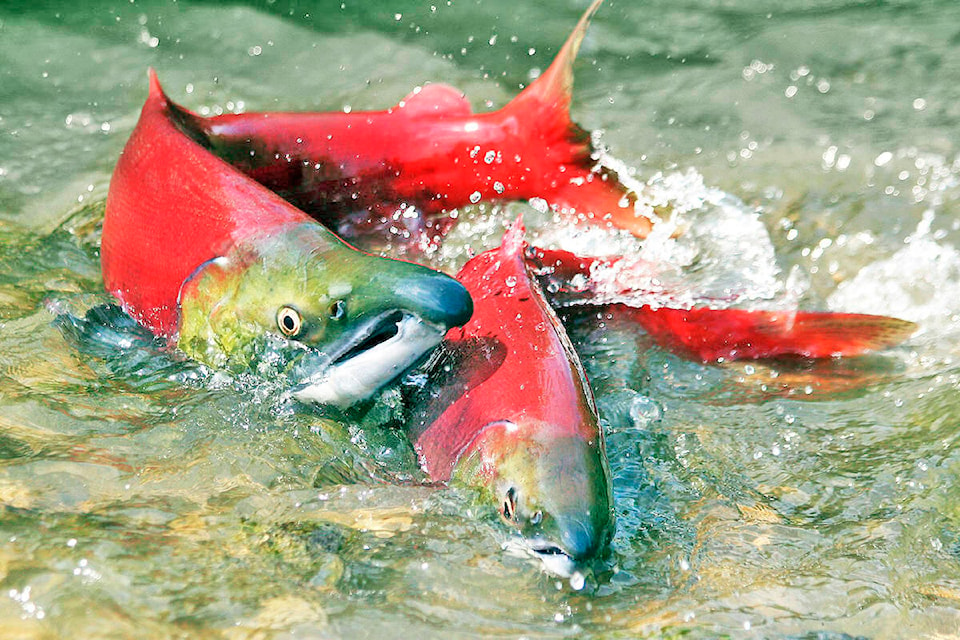Longtime marine fisherman Howard Gray is frustrated with the federal government’s management of the commercial sockeye harvest around Prince Rupert and afraid it will lead to two million dead fish that should have been caught in the ocean this year, he said on Aug. 3.
Gray has been commercial fishing on the North Coast for more than 60 years, primarily harvesting salmon and herring.
“A multi-million dollar travesty is happening as we speak. There’s going to be in excess of three million fish, sockeyes, going into the system, which is about two million more than there should be,” he said.
Gray believes the rules that Fisheries and Oceans Canada (DFO) announced regarding the commercial sockeye fishery were not in line with the high number of fish returning this year.
A notice pertaining to commercial fishing on July 28 and July 29 stated that fishermen could use a maximum net length of 100 fathoms (187.5 metres), which is considered a “half-length net.” A second rule limited fishers to a 20-minute soak time, which refers to the maximum amount of time they are allowed to have their nets in the water from the time it is completely set to the time it begins to be retrieved.
Both of these rules limit the volume of sockeye commercial boats can harvest.
Gray is upset the fish are going to die without reproducing because with so many swimming up the river to spawn the streams will not be able to accommodate them, he said.
“The fish are going to end up in the Babine Lake. The majority of them will die. They won’t spawn, they close the fences off so you have a little bit of wild stock and the rest of it just dies in the lake. Well in excess of a million — they’ll end up dying for sure. This happened before. They’ve allowed too many fish in there and what it does, it screws up the next run,” Gray said.
Donna MacIntyre, Lake Babine Nation’s Fisheries Director, defended the regulations saying they were put in place by DFO to protect the wild salmon stocks.
She explained that the ocean sockeye fishery is a mixed stock. There is both wild sockeye and enhanced sockeye.
The enhanced salmon come from artificial streams where humans manage the conditions, creating an ideal, manufactured environment for the fish to lay their eggs, she said.
“So all of a sudden, you’ve got tons and tons of fish that have been produced from these artificial rivers, which are the spawning channels, and we get, like this year, a lot of fish back.”
In comparison, the wild sockeye, which is returning to their natal streams in Lake Babine Territory, is in major danger, she said.
“So just imagine a pile of fish swimming together. Can you tell which one’s enhanced and which one’s not enhanced?” MacIntyre posed.
The harvest regulations for commercial marine fishermen are in place, so they do not unintentionally target the wild stocks that swim alongside the enhanced fish, she said.
“I call the spawning channels a blessing and a curse because they produce lots of sockeye. It’s a curse because of this mixed stock fishery. But then we don’t know what’s going to happen in the future if all of a sudden these enhanced fish end up with a disease and they get it every year or something weird happens.”
It’s her opinion that “when you mess with Mother Nature, it comes back. She bites you and gets you hard”.
Gray doesn’t see the enhanced fish as being different from the wild stocks.
“They are wild fish that go into a spawning channel. A spawning channel is like a ditch that has gravel and what, it’s not a hatchery… Where it comes from is from the wild stock,” he said.
After more than six decades on the water as a commercial fisherman, Gray said he didn’t even bother going to the fishery this year.
“I refuse to cut a net in half and the 20-minute set is ridiculous,” he said.
READ MORE: Resident anglers fed-up with governments’ ‘short-sighted’ fishery management
READ MORE: DFO closes chinook salmon fishing around Prince Rupert
Kaitlyn Bailey | Local Journalism Initiative Reporter
Send Kaitlyn email
Send The Observer email
Like the The Northern View on Facebook
Follow us on Twitter
